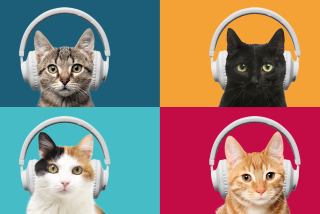Years After Giant Flop, Online Media Take Hold
To watch most of his favorite programs, James Finn doesn’t turn on the TV. He boots up his computer.
The 25-year-old manager of a Baltimore movie theater spends as many as four hours a day on ManiaTV.com, checking out music videos, extreme sports highlights and short films streamed over the Internet.
“I used to watch TV three or four hours a day,” Finn said. “Now I’m down to about two hours of TV a week.”
Five years ago, at the height of the dot-com boom, entrepreneurs and visionaries predicted that new online venues would overtake traditional media as viewers like Finn enjoyed shows and other content tailored to their tastes and schedules.
It didn’t happen.
High-speed Internet connections were rare, and few people were willing to wait hours for a 10-minute video clip to download. Plus, most people’s idea of on-demand entertainment was a drive to the local video store. The brutal tech bust seemed to close the book on the aspirations of those who envisioned the Internet transforming the way news and entertainment were produced and consumed.
But it turns out the dot-com crash may just have been the prologue. After licking their wounds, a rash of companies -- including small players such as ManiaTV, Web giants such as Yahoo Inc. and traditional media titans such as Walt Disney Co. -- are again investing heavily to bring more audio and video to the Internet.
This time, though, few people expect a crash because the companies are making money, capturing audiences and, yes, transforming the way news and entertainment are produced and consumed.
Technology has improved. People have grown accustomed to getting news on their BlackBerries and watching video on their computers. And old-media giants are working with the new-media leaders to make changes more soberly.
More than 20% of people who read newspapers rely primarily on online editions. Consumers watched 2.9 billion music videos, live performances and interviews on the Yahoo Music website last year. Apple Computer Inc.’s iTunes Music Store sells 40 million songs a month.
Google Inc., which sells online ads, vies with Time Warner Inc. as the world’s most valuable media company. Advertisers spent $9.6 billion to place ads online in the U.S. last year. That’s still only 6% of all ad spending, but it’s growing fast.
Rather than supplanting traditional media, the Internet is viewed as a way to support and expand it.
“The competitive arena is only going to expand,” said Patrick Mahoney, an analyst who follows consumer technologies for research firm Yankee Group. “I don’t think consumers are completely shifting away from traditional entertainment, but they are starting to shift the time spent and money spent” onto the Internet.
Traditional outlets -- newspapers, magazines, radio, television -- still dominate most people’s media diets and soak up most advertising dollars. And analysts caution that it will be a long time before new media rival the old. Among the challenges: increasing broadband penetration, making home networks easier to set up, getting devices from different manufacturers to work together better, ironing out thorny copyright issues and figuring out new business models.
But big media companies, which are likely to dominate online entertainment, are acquiring Internet upstarts at a furious pace. The most recent: Viacom Inc.’s MTV Networks last week snapped up youth website Neopets.com for $160 million. The following day, Time Warner’s America Online began offering free ad-supported music and short films once available only to its subscribers.
Those who survived the dot-com bust largely agree that their vision of the Internet transforming media wasn’t wrong, just a little early.
“People have realized it’s not going to happen overnight,” said Steve Wadsworth, president of Walt Disney Internet Group. “It’s more of an evolution than a revolution.”
What’s changed? A lot.
* Half of U.S. homes with Internet accounts are connected at high speed. Last time around, Internet companies had to force content down dial-up connections, meaning it could take hours to download even a short movie. With fast connections, people have become more used to watching video online, and software advances have made the images much crisper.
* Living-room devices such as TiVo Inc.’s personal video recorder and Microsoft Corp.’s Xbox video game console are bridging the gap between the Internet and the television. With wireless networks, photos, songs and video files can be moved around one’s home and watched on the most convenient screen.
* Mass entertainment is being fractured into thousands of customizable programs that can be watched or listened to anytime and anywhere. TiVo’s recorder and Apple Computer’s iPod blew up the traditional methods for delivering media and gave consumers a taste for getting personalized content on their own terms.
* Chip makers are building connectivity into the silicon that powers devices, making cellphones and hand-held computers capable of many tasks once reserved for PCs. Faster wireless data networks have spurred a flurry of deals between content providers and mobile companies, such as music service Napster Inc. and cellphone maker Ericsson, that let people turn to their phones’ tiny screens for news and entertainment. Millions of digital cameras, cellphones and portable game consoles have ways to connect to one another and to the Internet.
* There’s more interesting stuff to watch and listen to. The recording industry makes almost all of its new music available via paid downloads or online subscription services, and Internet giants are pushing movie and TV studios to follow suit. Yahoo and AOL are starting to create original Web-only programming of their own. Advertisers and consumers are creating their own short films that are spread by e-mail.
* And, perhaps most importantly, there’s money to pay for all this online media. Advertisers are diverting more of their budgets to the Internet and other interactive media in search of consumers. Yahoo, Google, AOL and Microsoft’s MSN -- the four biggest online media players -- each reaped more than $1 billion in advertising revenue last year, and all are growing fast.
ManiaTV Network Inc., for instance, is less than a year old but attracted 1 million viewers last month. That’s enough to bring in some high-profile advertisers from broadcast TV, including Levi Strauss & Co., Dodge and the U.S. Navy.
“We looked at it and said, ‘This is MTV 20 years ago,’ ” Levi spokeswoman Amy Gemellaro said.
Entrepreneur Drew Massey hatched the idea for ManiaTV in 1998, as many companies were spending furiously to get people to watch video clips on their computers. He knew they were onto something, but he didn’t think the world was ready.
Massey waited to start the company until broadband connections reached 20 million households -- the same threshold cable television reached before advertisers took it seriously.
“We’re tapping into a 60-year-old business model, but we’re using a new distribution method,” Massey said. “This distribution method happens to be interactive, worldwide and incredibly addictive for the youth market.”
It’s not just young, tech-obsessed men who like to slice and dice their media.
Megan Walker, a 34-year-old high school English teacher who’s on leave to care for her 7-month-old son, Ethan, discovered this spring that she could download individual songs through iTunes instead of buying whole albums. And her TiVo has been a revelation.
“I hate TV,” she said. “But I do love one TV show: ‘Six Feet Under.’ I can watch it whenever I want, especially now that I have a baby. We only put it on after he’s in bed. The downside is that I end up watching more TV than I would like.”
Thanks to digital media, movies and shows are spreading to gadgets other than the living room TV set. This month, TiVo teamed up with Microsoft and Intel Corp. to launch a feature that lets users transfer recorded shows to devices that run Microsoft’s Windows Media Player software, including portable video players, fancy phones and hand-held organizers.
The transformation is a risky proposition for the major Hollywood studios. It threatens to give upstart entertainment companies a direct route into the home outside the control of broadcast and cable networks. It also has put a trove of bootlegged movies and TV shows within easy reach of people around the globe.
The Supreme Court ruled this week that file-sharing companies could be held liable for their users’ piracy, but almost no one in Hollywood or Silicon Valley thinks illegal swapping of music and video is going away.
Rather, a number of studio executives believe that if they make movies and programs more accessible online, the public will buy more, and their marketing and production budgets will help them dominate the new pipelines just as they have dominated the old ones.
Until the content-protection and home-networking issues get worked out, small companies are the ones turning heads at Hollywood studios with their commitment to personalizing the delivery of video. Firms like ManiaTV and AtomShockwave Corp., whose AtomFilms.com shows short movies, “might be under the radar, but they are very clearly on the radar of the majors as to best practices,” said Paul Campbell, a Microsoft business-development executive working with the entertainment industry.
Online animation studio Mondo Media, for instance, stopped work on almost all of its cartoons after the bottom fell out of the Internet advertising market in 2000 and 2001.
The exception was a cartoon series called “Happy Tree Friends,” the dizzily bloody tales of forest animals that meet decidedly unhappy ends. Mondo kept churning out episodes, confident that the show could build a big audience online and that advertising would rebound.
“Happy Tree Friends” now draws 15 million unique viewers a month -- enough to persuade advertisers to pay $300,000 or more for the commercial slot in front of each monthly episode. Mondo has sold half a million copies of “Happy Tree Friends” DVDs, not to mention a rich bounty of “Happy Tree Friends” merchandise.
That gets the attention of traditional media companies.
“The digital age is upon us,” incoming Disney Chief Executive Robert Iger said at a recent conference for investors. “It’s vital for us to migrate ... to new media platforms.”
In the meantime, Web giants are trying to drag more big-media programming online so they can draw more advertising. They’re also making plans to create their own multimedia content.
The biggest Internet portal, Yahoo, has shifted many executives from its Sunnyvale, Calif., headquarters to a massive new office in Santa Monica, seeking to persuade Hollywood to promote and distribute more shows, films, music and games online. Yahoo CEO Terry Semel, former chairman of the Warner Bros. movie studio, hired several top entertainment-industry executives, including Lloyd Braun, former chairman of ABC Entertainment Television Group, to run Yahoo Media Group.
AOL, the world’s biggest Internet service provider, is taking more dramatic steps, revamping its business in a bid to cash in on the online ad boom. In addition to moving much of its music and video programming outside the “walled garden” once reserved for AOL subscribers, it’s also creating original programming -- something industry watchers expect Yahoo to do as well.
“Convergence -- that terminology fell out of favor,” said Ted Leonsis, vice chairman of America Online. “But you’re starting to hear people whisper it again.”
Times staff writers James S. Granelli, Jon Healey, Terril Yue Jones, Joseph Menn and Alex Pham contributed to this report.






